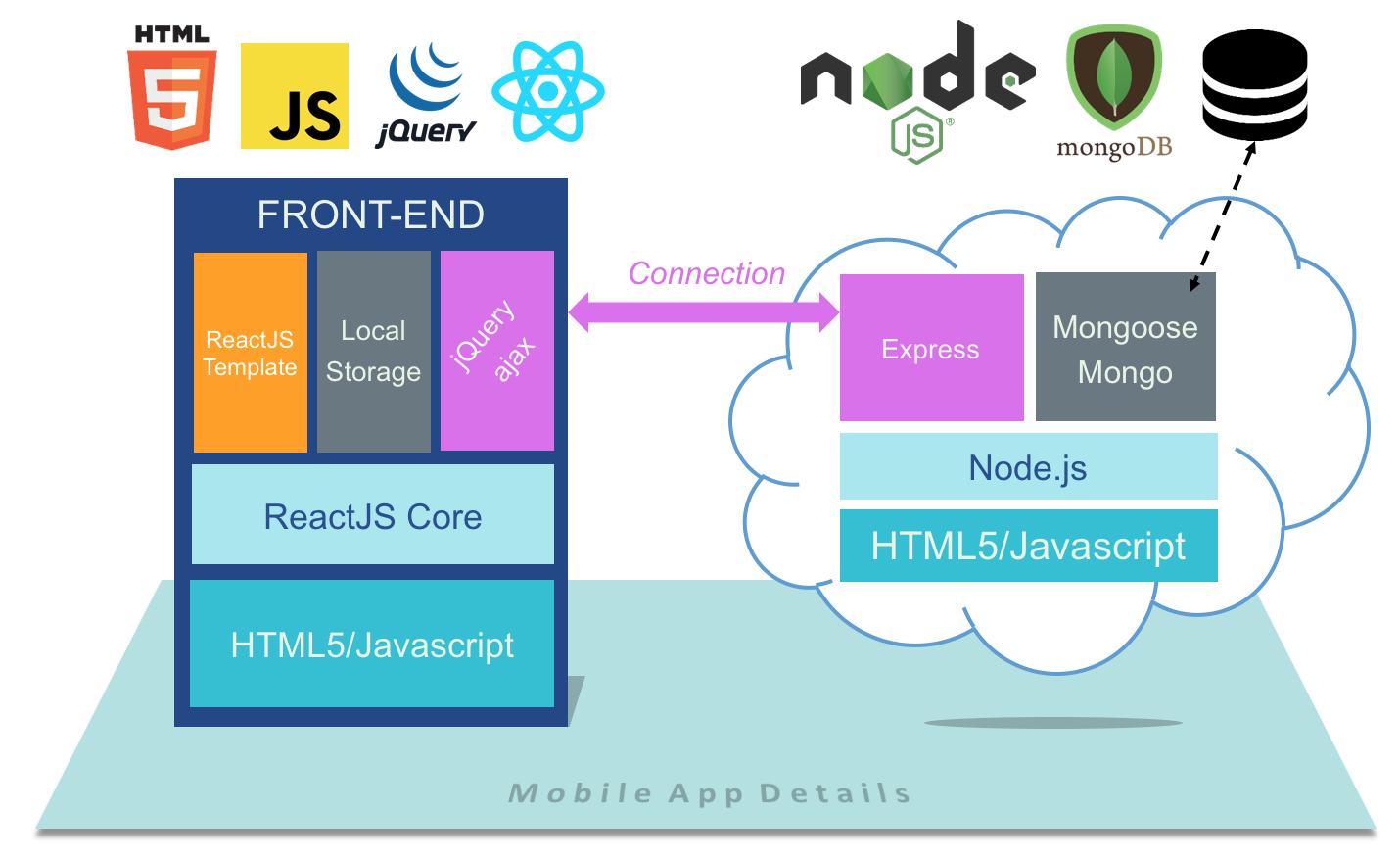ReactJS - 1.2
Extension ID
com.castsoftware.reactjs
What’s new?
Please see ReactJS - 1.2 - Release Notes for more information.
Description
This extension provides support for the ReactJS and React Native framework.
When the source code is written in TypeScript, the support for React is provided by the TypeScript extension.
In what situation should you install this extension?
If your Web application contains ReactJS or React Native source code and you want to view these object types and their links with other objects, then you should install this extension:
- creates HTML fragments, ReactJS applications, ReactJS components and ReactJS Forms.
- creates links between these objects.
|
| ReactJS Javascript Front-end connected to Node.js/Express/MongoDB Back-end |
Supported versions
The following table displays the list of ReactJS versions that this extension supports:
Version
|
Supported
|
|---|---|
| 15.x | |
| 16.x | |
| 17.x |
Files analyzed
| Icon(s) | File | Extension | Notes |
|---|---|---|---|
|
HTML |
*.html, *.htm, *.xhtml |
|
|
Javascript | *.js |
|
|
Cascading Style Sheet | *.css |
|
|
Java Server Page | *.jsp |
|
|
JSX | *.jsx | |
|
Active Server Page | *.asp, *.aspx |
|
|
HTML Components | *.htc | HTC files contain html, javascript fragments that will be parsed. Created objects will be linked to the HTC file. |
|
.NET Razor | *.cshtml |
|
Function Point, Quality and Sizing support
This extension provides the following support:
- Function Points (transactions): a green tick indicates that OMG Function Point counting and Transaction Risk Index are supported
- Quality and Sizing: a green tick indicates that CAST can measure size and that a minimum set of Quality Rules exist
| Function Points (transactions) |
Quality and Sizing |
|---|---|
AIP Core compatibility
This extension is compatible with:
AIP Core release
|
Supported
|
|---|---|
| 8.3.x |
Dependencies with other extensions
Some CAST extensions require the presence of other CAST extensions in order to function correctly. The ReactJS extension requires that the following other CAST extensions are also installed:
Note that when using the CAST Extension Downloader to download the extension and the Manage Extensions interface in CAST Server Manager to install the extension, any dependent extensions are automatically downloaded and installed for you. You do not need to do anything.
Download and installation instructions
The extension will be automatically downloaded and installed in CAST Console when you deliver React code. You can manage the extension using the Application - Extensions interface:
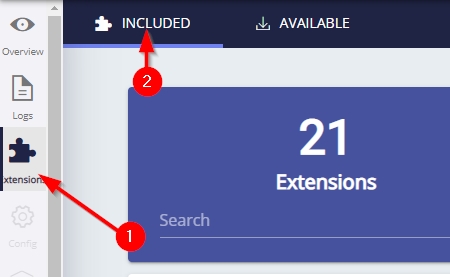
Analysis using CAST Imaging Console
CAST Imaging Console exposes the technology configuration options once a version has been accepted/imported, or an analysis has been run. Click Universal Technology (3) in the Config (1) > Analysis (2) tab to display the available options for your ReactJS source code:
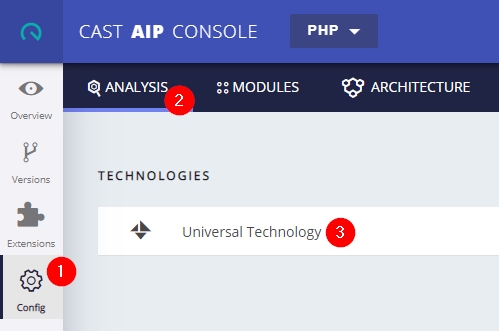
Then choose the relevant Analysis Unit (1) to view the configuration:
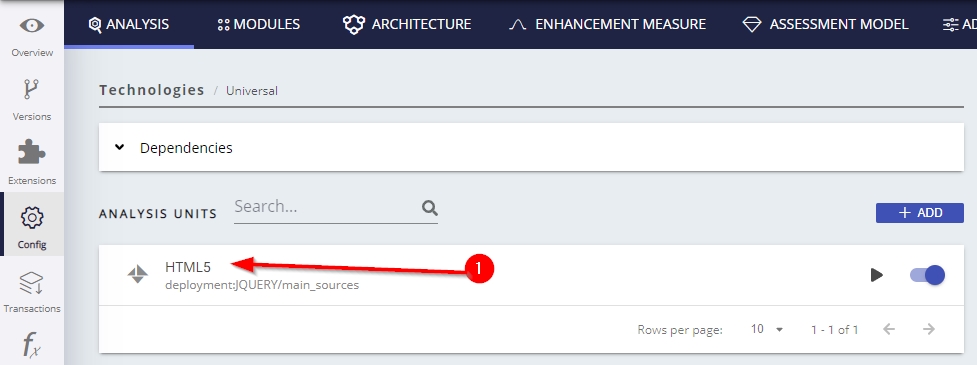
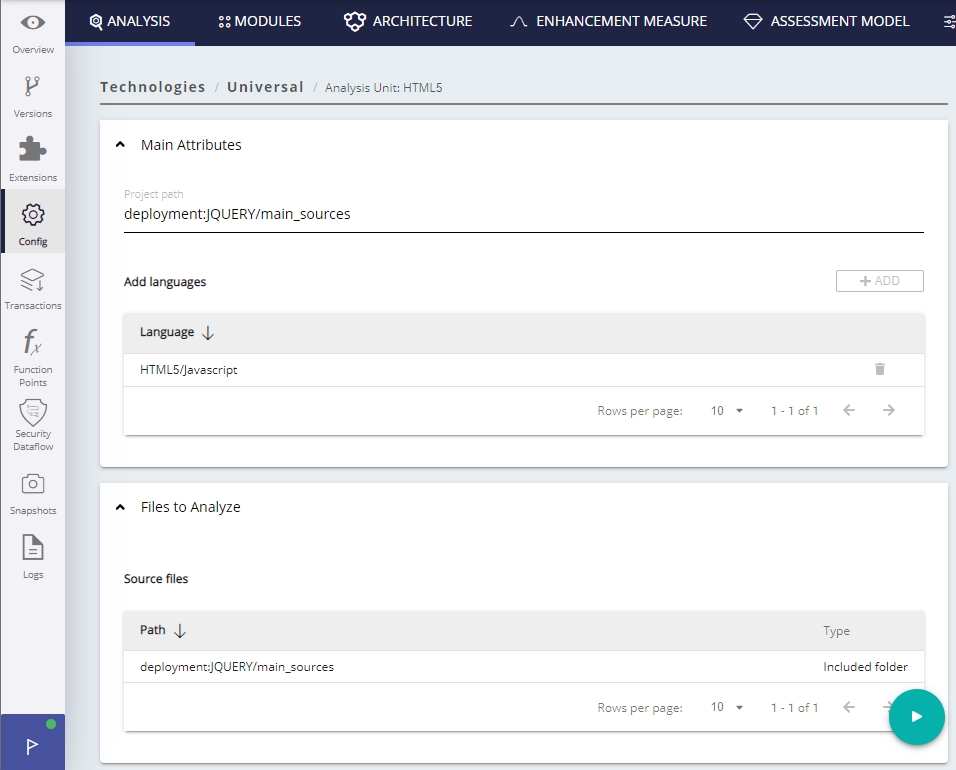
What results can you expect?
Objects
The following objects are identified:
| Icon | Metamodel name |
|---|---|
|
ReactJS Application |
|
ReactJS Component |
|
ReactJS Function Component |
|
HTML5 HTML fragment |
|
ReduxJS Handler |
Examples
ReactJS Application
The Application name is the file name or the parent directory name if the file name is “index”. The following declarations will create a ReactJS application:
html fragment in ReactDOM.render() call:
import { Provider } from 'react-redux';
import { AppContainer } from 'react-hot-loader';
ReactDOM.render(
<AppContainer>
<Provider store={store}>
<App version={appVersion} />
</Provider>
</AppContainer>,
appElement
);
html fragment containing “Provider” or “AppContainer” tags, in or out of ReactDOM.render() call:
import { AppContainer } from 'react-hot-loader';
<AppContainer>
<App version={appVersion} />
</AppContainer>
In the code examples shown above, a relyon link is created from the application to the HTML fragment of the application:
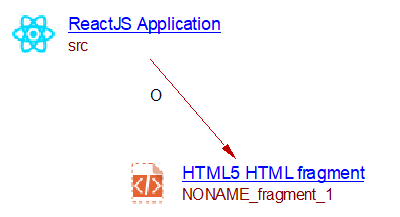
ReactJS Component
This declaration will create a ReactJS component named UserContainer because the class inherits from Component or PureComponent. A component corresponds to a class which contains a render method. The render method is automatically called when the component is referred to in an HTML fragment.
In the function “mapDispatchToProps”, there are mapping of functions which are used to find resolutions from HTML fragments to functions. The example below shows a “deleteUsers” function:
import React, { Component } from 'react';
class UserContainer extends Component {
componentDidUpdate(prevProps) {
...
}
componentDidMount = () { ... };
render() {
return (
<g>
{this.props.sequence.map((nucleotide, index) =>
<Nucleotide
type={nucleotide}
position={this.props.positionFrom + index}
key={index}
index={index}
onClick={this.props.onNucleotideClick}
{...this.props}
/>,
)}
</g>
);
}
}
function mapDispatchToProps(dispatch) {
return {
createUsers: bindActionCreators(createUsers, dispatch),
searchUsers: bindActionCreators(searchUsers, dispatch),
getUsers: bindActionCreators(getUsers, dispatch),
triggerNotification: bindActionCreators(triggerNotification, dispatch),
resetUsersActionStatus: bindActionCreators(resetUsersActionStatus, dispatch),
deleteUsers: bindActionCreators(deleteUsers, dispatch),
resetSearchUserApiStatus: bindActionCreators(resetSearchUserApiStatus, dispatch),
getRoles: bindActionCreators(getRoles, dispatch),
setConfigDetails: bindActionCreators(setConfigDetails, dispatch),
};
}
function mapStateToProps(state) {
return {
loginUsersList: state.admin.loginUsersList,
imagingUsersList: state.admin.imagingUsersList,
usersActionStatus: state.admin.usersActionStatus,
searchUserApiStatus: state.admin.searchUserApiStatus,
securityMode: state.login.securityMode,
deleteUserStatus: state.admin.deleteUserStatus,
rolesList: state.admin.rolesList,
};
}
export default compose(withStyles(tableStyles), connect(mapStateToProps, mapDispatchToProps))(UserContainer);
The code example above will give the following results:
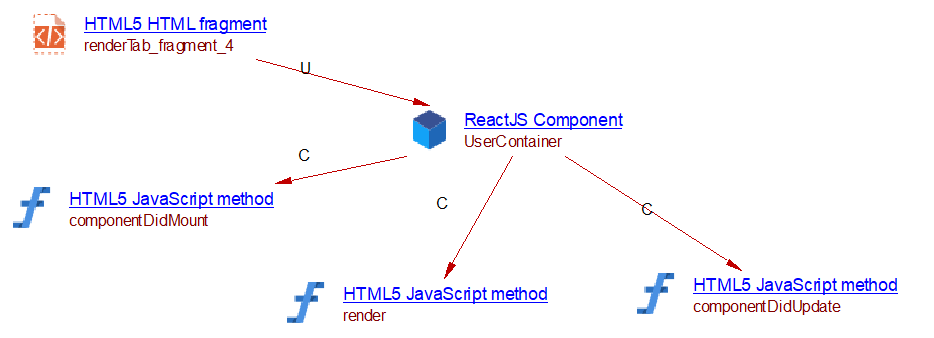

- call links are created from the component to its following
methods when they exist:
- ‘render’
- ‘shouldComponentUpdate’
- ‘componentWillReceiveProps’
- ‘componentWillUpdate’
- ‘componentWillMount’
- ‘componentWillUnmount’
- ‘componentDidUpdate’
- ‘componentDidMount’
- ‘componentDidUnmount’
- these components may be called from html fragments anywhere in code, for example:
<Route
exact={true}
path={`${basePath}/apps`}
component={UserContainer}
/>
or
<UserContainer ... />
- Functions referred to in the “mapDispatchToProps” function may be referenced anywhere in the code for example:
<AlertDialog
onClick={this.deleteUsers}
/>
ReactJS Function Component
This declaration will create a ReactJS function component named ReportContainer because the function is exported in one of the following statements:
-
export default withRouter(connect(mapStateToProps, mapDispatchToProps)(ReportContainer));
-
export default connect(null, mapDispatchToProps)(ReportContainer);
-
export default connect(mapStateToProps, mapDispatchToProps)(withStyles(stylesTheme)(ReportContainer));
-
export default connect(mapStateToProps, mapDispatchToProps)(RedirectIfNotGranted(ReportContainer, ‘STORE_ORDER_READ’, ‘store’));
-
export default withStyles(styles)(connect(mapStateToProps, mapDispatchToProps, null, {withRef: true})(ReportContainer));
-
export default compose(withStyles(styles), connect(mapStateToProps, mapDispatchToProps))(ReportContainer);
-
export default withStyles(styles)(ReportContainer);
-
export default compose(withReducer, withSaga, withConnect)(injectIntl(ReportContainer));
-
export default memo(ReportContainer);
When none of these exports are present, but there is one simple function export and this function contains a “return” statement returning a jsx expression, a reactjs function component is also created.
For example, the file report/img-report-container.jsx:
import { connect } from 'react-redux';
import { bindActionCreators } from 'redux';
const ReportContainer = (props) => {
const { isReportDialog, reportList, appName, reportDownloadQueue, reportQueue,
reportActions, triggerDownload: { nextDownload, activeReportId } } = props;
...
}
function mapStateToProps(state) {
return {
isReportDialog: state.report.isReportDialog,
reportList: state.report.reportList,
appName: state.dataSource.selectedApp.value,
reportDownloadQueue: state.report.reportDownloadQueue,
reportQueue: state.report.reportQueue,
triggerDownload: state.report.triggerDownload,
};
}
function mapDispatchToProps(dispatch) {
return {
reportActions: bindActionCreators(Object.assign({}, Actions), dispatch),
triggerNotification: bindActionCreators(triggerNotification, dispatch),
};
}
export default connect(mapStateToProps, mapDispatchToProps)(ReportContainer);
Will give the following results:

- A call link is created from the function component to its function.
- These components may be called from html fragments anywhere in code, for example:
import ReportDialog from '../report/img-report-container';
...
<ReportDialog />
- The same is true for the “mapDispatchToProps” function as for ReactJS components.
HTML fragment
This declaration will create an HTML fragment named render_fragment_1 starting with “<g>” and ending with “</g>”. There can be several fragments in any function/method:
render() {
return (
<g>
{this.props.sequence.map((nucleotide, index) =>
<Nucleotide
type={nucleotide}
position={this.props.positionFrom + index}
key={index}
index={index}
onClick={this.props.onNucleotideClick}
{...this.props}
/>,
)}
</g>
);
}
When you have purely JavaScript code inside an html fragment, the JavaScript code is analyzed and you will obtain links exactly as you would have in conventional JavaScript code. You can also have JavaScript functions inside HTML fragments, in this case, functions are children of the HTML fragment.
In the code example for the ReactJS application above, we can see that it contains also a HTML fragment.
Redux support
The React Redux library, often used in combination with ReactJS, is supported. A specific object “ReduxJS handler” is created.
Imports
the following imports are supported:
-
redux
-
redux-saga
-
redux-saga/effects
-
redux-thunk
-
@reduxjs/toolkit
-
redux-define
Examples:
import {createStore, applyMiddleware} from 'redux'
import {combineReducers} from 'redux'
import { takeLatest } from 'redux-saga';
import thunkMiddleware from 'redux-thunk';
import { createSlice } from '@reduxjs/toolkit';
import { createAction } from '@reduxjs/toolkit';
import { bindActionCreators } from 'redux';
import { call, fork, put, takeLatest, select } from 'redux-saga/effects';
import { defineAction } from 'redux-define';
Calls
The following calls are supported:
- createSlice
- createAction
- defineAction
- useDispatch
- combineReducers
- injectReducer
- dispatch
- takeLatest, takeEvery, take, takeMaybe, all, race, put, call, fork, select (all imports from redux-saga/effects)
Examples
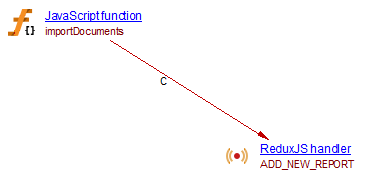
import { call, fork, put, takeLatest, select } from 'redux-saga/effects';
yield put({ type: reportConstants.ADD_NEW_REPORT, ...});
export default function reportReducer(state = initialState, action) {
switch (action.type) {
case constants.ADD_NEW_REPORT: return { ...state, reportDownloadQueue: action.payload };
case constants.TRIGGER_REPORT_DOWNLOAD: return { ...state, triggerDownload: { ...action.payload } };
default: return state;
}
}
ADD_NEW_REPORT handler is on “return { …state, reportDownloadQueue: action.payload };” code (the “case” corresponding to ADD_NEW_REPORT).
The “reportReducer” function is seen as the parent of handlers by the presence of following code:
import { applyMiddleware, createStore, combineReducers } from 'redux';
const appReducer = combineReducers({
report: report.ReportReducer,
smartSearch: smartSearch.SmartSearchReducer,
overview: overview.OverviewReducer,
tileExpand: tileExpand.TileExpandReducer,
configCenter: configCenter.ConfigReduces,
});
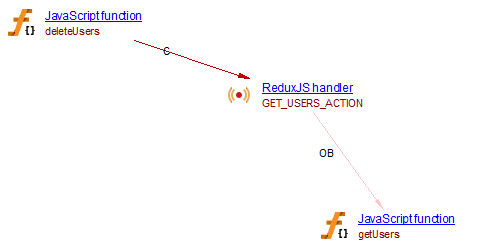
import { call, fork, put, takeLatest, select } from 'redux-saga/effects';
yield put({ type: constants.GET_USERS_ACTION });
export function* getUsers({ payload }) {
}
GET_USERS_ACTION is on “getUsers” function.
Correspondence between GET_USERS_ACTION and the function is found in following code (then, the handler is created):
import { call, fork, put, takeLatest, all } from 'redux-saga/effects';
yield takeLatest(constants.GET_USERS_ACTION, getUsers);
Structural Rules
The following structural rules are provided:
Known Limitations
- React Without JSX is not supported.
